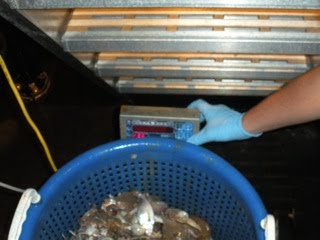 Birds, Sharks, Fish, Water Chemistry……. Everything needs to be monitored for the ‘big picture’
Birds, Sharks, Fish, Water Chemistry……. Everything needs to be monitored for the ‘big picture’NOAA Teacher at Sea: Kimberly Lewis
NOAA Ship: Oregon II
Mission: SEAMAP Summer Groundfish Survey
Geographical Area of Cruise: Gulf of Mexico
Date: Wednesday July 14, 2010
Weather Data from the Bridge
Time: 1115 (11:15 AM)
Position: Latitude 28.59.313 N, Longitude 94.28.958 W
Present Weather: partly cloudy
Visibility: 8 nautical miles
Wind Speed: 11.21 kts
Wave Height: 3 feet
Sea Water Temp: 29.7 C
Air Temperature: Dry bulb = 30.1 degrees Celsius; Wet bulb = 26.3
Barometric Pressure: 1017.50 mb
Science and Technology Log
(this log is a little lengthy, but very important concepts)
Southeast Fishery Bulletin released a statement on July 12, 2010 regarding the Shrimp Fishery to re-open on July 15, 2010 off the coast of Texas. Data that we have been collecting on board the Oregon II is sent daily to the regional office for review. From our data over the past week and data collected by the Texas parks and Wildlife Dept, the NOAA Fisheries Service has announced the size of the brown shrimp have reached a mark that allows the trawling to re-open from 9 to 200 nautical miles off Texas.
The shrimp fishery is closed annually off Texas to allow brown shrimp to reach a larger and more valuable size prior to harvest, and to prevent waste of brown shrimp that might otherwise be discarded due to their small size. http://sero.nmfs.noaa.gov/bulletins/fishery_bulletins.htm
During our sampling I have personally seen many sizes of shrimp. The past few days the brown shrimp have been very large. Personally, I have not seen shrimp this large before…… but living in Ohio most of our shrimp comes frozen and already beheaded.
When sexing shrimp the larger shrimp are usually female. This is the case with many species of organisms. As we are counting through the first 200 shrimp for data collecting, you can almost guess before looking what the sex of some shrimp will be just based on their size.
Tuesday the idea of whole ecosystem-based management was addressed.
An article by Hughes (2009) shows a relationship between species of seagrass and the species that they provide with habitat and/or food source. The data shows the importance of an ecosystem-based mgmt approach that incorporates interdependencies and facilitation among species (Hughes et al. 2009). This is the concept that is taking place by the US National Marine Fisheries Service (which is a department within NOAA) in relation to the "essential fish habitat" which approaches the protection of sea-grasses (Hughes et al. 2009).
What about the IUNC (International Union for Conservation of Nature) Red List? As of now, threats to biodiversity are often listen on a species-by species basis (Hughes et al. 2009). The research in the Hughes (2009) article suggests looking at connections between threatened species and their habitats...... ecosystem-based conservation. Again, the NOAA fisheries have already started this trend.
Some things that are done on the NOAA fisheries ships to maintain low variables throughout the years of sampling are keeping the same gear and using the same sampling methods. As far as site selection, the stations are random stratified. An example of this would be not going to the same station year after year, but sampling 20 stations in Area A. So the following year it may be another random 20 stations in Area A.
Habitat quality also plays a role in sampling. Commercial fishermen may question why NOAA chooses to sample in a place that has low or no fish, but it is important to monitor all areas. As the high quality habitat looses fish due to the fishing industry, fish from another area will move in. At first glance it may seem like the populations are fine, but if the other areas are being depleted because fish are moving into the prime area you start to see a shift in an ecosystem.
Here in the gulf we are not seeing any invasive species in our sampling areas, which is great news. A few years back some Australian jellyfish were making their way in, but you mainly see those closer to the coast. We have had good catches while we have been out, in other words a good proportion of organisms based on the depth of the water.

"Sorting the Catch"
So finally what can I say about ecosystem management? Hooray for the US Nat'l Marine Fisheries!
Works Cited:
Hughes, R. Williams, S. Duarte, C. Heck, K. Waycott, M. 2009. Associations of concern: declining seagrasses and threatened dependent species. Frontiers in Ecology and the Environment: Vol. 7, No. 5, pp. 242-246.

"Shrimp, eels, various fish, etc."
Personal Blog:We have finished up our Texas stations and we are headed to the Louisiana west delta. I have been scrambling around to get some good photos of the lab, the sea, etc. because it has hit me that I only have two more days on the boat.
Usually journaling and photo taking come easy for me on my summer expeditions, but this one has really been a lot of work. With 12 hour shifts and trawling happening all throughout the night, there is not much down time. Which is probably fine b/c you are in the middle of the sea on a boat. What else would you do? This isn’t a Carnival cruise line. Hahaha.
I have really adjusted to sea life and night shift. Each day when I get off of my shift I hit the bed hard…… and don’t wake up until 10pm!
Chefs Walter and Paul have continued to feed us all well, too good at times. Everyone on the ship has kept their day 1 attitude and hospitality toward me and the other volunteers. It can be tough living in a small place, but it seems to work well on the Oregon II.





































